IndusInd Bank Bundle
Who Really Controls IndusInd Bank?
Understanding the intricate web of IndusInd Bank SWOT Analysis is crucial, especially considering the recent financial turbulence and leadership changes. The ownership structure of any company, including IndusInd Bank, is a pivotal indicator of its strategic direction and stability. This analysis dives deep into the key players influencing IndusInd Bank's trajectory, from its inception to the present day.
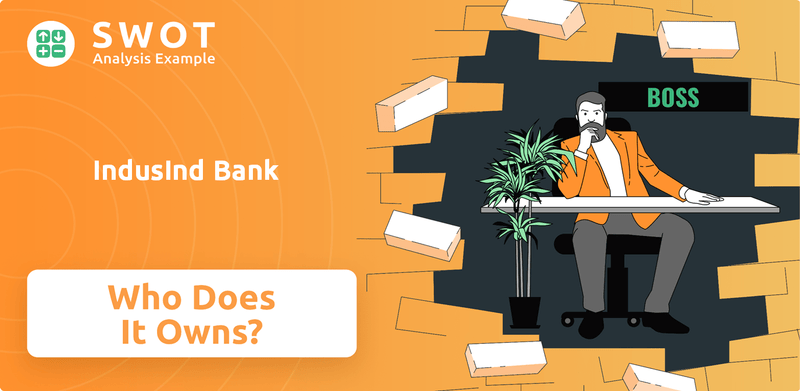
The recent accounting discrepancies at IndusInd Bank, resulting in significant financial repercussions, highlight the importance of scrutinizing the bank's ownership. This exploration of IndusInd Bank ownership will reveal the major stakeholders, including institutional and retail investors, and the impact of their holdings. Knowing who owns IndusInd Bank is vital for investors, analysts, and anyone seeking to understand the bank's future.
Who Founded IndusInd Bank?
The story of IndusInd Bank begins in April 1994, with S. P. Hinduja at the helm, alongside a group of Indian entrepreneurs and a large number of Non-Resident Indian (NRI) and other shareholders. While S. P. Hinduja is widely recognized as the founder, Dr. B. K. Ghotankar is also credited as a founder, contributing to the bank's early establishment. The bank's inception marked a significant moment in the Indian banking sector, aiming to introduce innovative banking solutions.
IndusInd Bank's launch on April 17, 1994, was marked by an initial capital base of Rs. 1 billion and a network of 20 branches. The bank's name, 'IndusInd,' reflects its commitment to blending innovation with sound business practices, drawing inspiration from the Indus Valley Civilization. This initial phase set the stage for the bank's future growth and its position in the financial landscape.
Initially, IndusInd Enterprises and Finance Limited, along with a group of individual investors, promoted IndusInd Bank. The bank's initial public offering (IPO) in 1997 was oversubscribed, showing strong early investor interest and confidence in the bank's potential. This early success paved the way for further developments in its ownership structure and market presence.
S. P. Hinduja is widely recognized as the founder of IndusInd Bank.
The bank started with an initial capital base of Rs. 1 billion.
The IPO was launched in 1997 and was oversubscribed.
Early shareholders included NRIs and other investors.
The bank commenced operations on April 17, 1994.
IndusInd Bank started with a network of 20 branches.
The Hinduja Group acquired a significant stake in 2002, strengthening the bank's market position. Further consolidation within the Hinduja Group occurred in 2004 with the merger of IndusInd Bank and Ashok Leyland Finance. Understanding the Growth Strategy of IndusInd Bank provides context to the ownership dynamics.
- Who owns IndusInd Bank is a key question for investors.
- The Hinduja Group is a major stakeholder.
- Early investors played a crucial role in the bank's initial growth.
- The ownership structure has evolved over time, with strategic acquisitions and mergers.
IndusInd Bank SWOT Analysis
- Complete SWOT Breakdown
- Fully Customizable
- Editable in Excel & Word
- Professional Formatting
- Investor-Ready Format
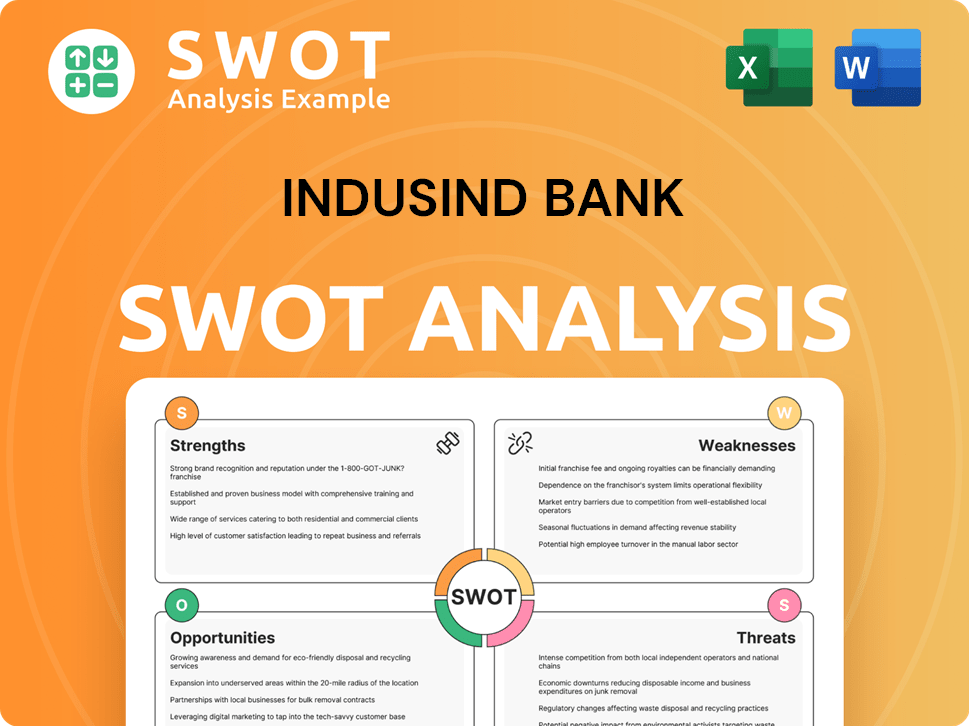
How Has IndusInd Bank’s Ownership Changed Over Time?
The ownership structure of IndusInd Bank has evolved significantly since its inception. The bank went public in 1997. A merger with Ashok Leyland Finance in 2004 further shaped its ownership. In 2007 and 2008, the bank issued global depository receipts (GDRs) on the Luxembourg Stock Exchange, raising ₹147 crore and ₹222 crore, respectively, which broadened its investor base.
These events highlight the bank's journey from a privately held entity to a publicly traded company with a diverse shareholder base. This evolution has been critical in shaping its financial strategy and growth trajectory, influencing its ability to attract capital and expand its operations. Understanding this history is crucial for assessing the bank's current position and future prospects, as changes in ownership can directly impact its strategic direction and operational performance.
| Shareholder Type | Stake as of March 2025 | Stake as of December 2024 |
|---|---|---|
| Hinduja Group (Promoter) | 15.83% | N/A |
| Foreign Portfolio Investors (FPIs) | 29.53% | 24.74% |
| Domestic Mutual Funds | 27.55% | 30.31% |
| Life Insurance Corporation of India (LIC) | 5.08% | 5.23% |
| Retail Shareholders | 9.17% | 7.9% |
As of March 2025, the Hinduja Group, through IndusInd International Holdings Ltd (IIHL) and IndusInd Ltd, remains the promoter of IndusInd Bank, holding a combined 15.83% stake. IIHL alone held 12.06%. Institutional investors, including foreign portfolio investors (FPIs), domestic mutual funds, and Life Insurance Corporation of India (LIC), hold a significant portion of the shares. FPIs increased their stake to 29.53%, while domestic mutual funds reduced their stake to 27.55%. Retail shareholding also increased. These shifts in major shareholding can significantly influence company strategy and governance, as seen with the recent accounting discrepancies and subsequent leadership changes. For a broader view, you can check the Competitors Landscape of IndusInd Bank.
The Hinduja Group remains the primary promoter, but institutional investors hold a substantial portion of the shares.
- FPIs have increased their stake, indicating growing international investor confidence.
- Domestic mutual funds have decreased their holdings.
- Retail investor participation is on the rise, reflecting increased public interest.
- The Reserve Bank of India (RBI) approved the Hinduja Group to increase its stake to 26% in March 2023.
IndusInd Bank PESTLE Analysis
- Covers All 6 PESTLE Categories
- No Research Needed – Save Hours of Work
- Built by Experts, Trusted by Consultants
- Instant Download, Ready to Use
- 100% Editable, Fully Customizable
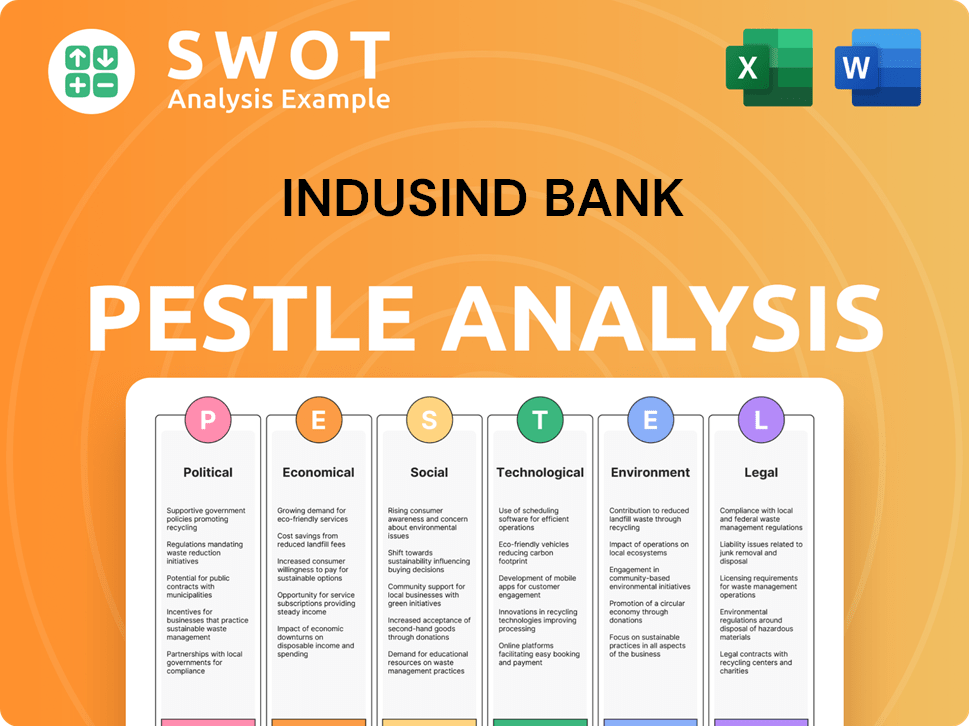
Who Sits on IndusInd Bank’s Board?
The Board of Directors of IndusInd Bank is pivotal in steering its strategic direction and ensuring robust governance. As of May 2025, the board is chaired by Sunil Mehta. Key members include T. T. Ram Mohan, Akila Krishnakumar, Rajiv Agarwal, Bhavna Doshi, Jayant Deshmukh, Pradeep Udhas, Lingam Venkata Prabhakar, Rakesh Bhatia, and Sudip Basu. The Hinduja Group, the promoter, holds a significant stake, thereby wielding considerable influence over board appointments and voting outcomes.
The Hinduja Group's stake in IndusInd Bank is substantial, with a holding of 15.83% as of March 2025. They have received approval to increase their stake to 26%, which underscores their dominant position in the bank's ownership structure. This significant ownership gives them considerable influence over the bank's strategic decisions and governance practices.
| Board Member | Role | Details |
|---|---|---|
| Sunil Mehta | Chairman | Oversees board meetings and strategic direction. |
| T. T. Ram Mohan | Director | Contributes to policy and governance. |
| Akila Krishnakumar | Director | Provides expertise in financial matters. |
| Rajiv Agarwal | Director | Brings experience in banking and finance. |
| Bhavna Doshi | Director | Focuses on governance and compliance. |
| Jayant Deshmukh | Director | Offers insights into operational strategies. |
| Pradeep Udhas | Director | Contributes to risk management oversight. |
| Lingam Venkata Prabhakar | Director | Provides expertise in financial services. |
| Rakesh Bhatia | Director | Offers insights into business strategies. |
| Sudip Basu | Director | Contributes to financial oversight. |
The voting structure at IndusInd Bank generally follows a one-share-one-vote principle. However, the influence of major shareholders like the Hinduja Group and large institutional investors is significant due to their substantial holdings, which impacts the bank's decision-making processes. Recent governance issues, including accounting discrepancies, led to regulatory intervention. The Reserve Bank of India (RBI) intervened in March 2025, prompting the resignation of the MD & CEO and Deputy CEO. An interim executive committee was appointed to manage operations until a new MD & CEO is selected, highlighting the RBI's direct oversight. The bank is actively working to fill the CEO position, a requirement for private sector banks under RBI norms.
The Hinduja Group is the promoter and a major shareholder of IndusInd Bank, holding a significant stake.
- The board of directors includes experienced professionals.
- The RBI has intervened in governance matters, impacting leadership changes.
- The bank is currently seeking a new MD & CEO.
- Understanding the IndusInd Bank ownership structure is crucial for investors.
IndusInd Bank Business Model Canvas
- Complete 9-Block Business Model Canvas
- Effortlessly Communicate Your Business Strategy
- Investor-Ready BMC Format
- 100% Editable and Customizable
- Clear and Structured Layout
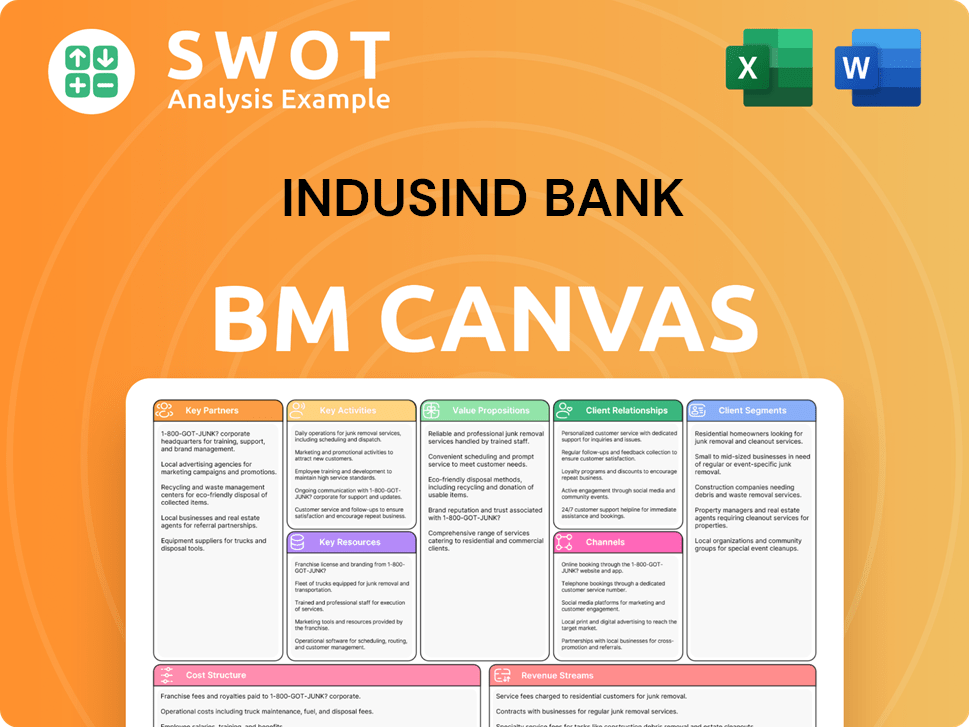
What Recent Changes Have Shaped IndusInd Bank’s Ownership Landscape?
Over the past few years, IndusInd Bank's ownership structure has seen significant shifts. These changes reflect both internal challenges and broader industry trends. A major development was the disclosure of accounting discrepancies in its derivatives portfolio, initially estimated at approximately ₹2,100 crore (about $250 million) and later quantified by an external agency at ₹1,979 crore as of June 30, 2024. This led to a substantial drop in the bank's share price, plummeting by 27.17% on March 11, 2025.
The Reserve Bank of India (RBI) intervened, resulting in the resignations of key executives in April 2025. The bank is now forming an executive committee and seeking RBI approval for new leadership. These events have influenced the bank's shareholder composition, with notable changes among different investor groups. Understanding the dynamics of IndusInd Bank ownership is crucial for assessing its future.
| Shareholder Category | March 2025 | December 2024 |
|---|---|---|
| Promoter (Hinduja Group) | 15.83% | 16.29% |
| Foreign Portfolio Investors (FPIs) | 29.53% | 24.74% |
| Domestic Mutual Funds | 27.55% | 30.31% |
The Hinduja Group, the IndusInd Bank parent company, plans to increase its stake to 26% through a new fundraise, having received in-principle approval from the RBI in March 2023. Foreign portfolio investors (FPIs) increased their holdings, showing confidence, while domestic mutual funds reduced their stake. The bank's Q4 FY2024-25 results reported a consolidated net loss of ₹2,328.9 crore, primarily due to higher provisioning and reduced interest income. These changes highlight the dynamic nature of IndusInd Bank shareholders, influenced by corporate governance issues, regulatory actions, and investor confidence. To learn more about the bank's strategic approach, you can read about the Marketing Strategy of IndusInd Bank.
The Hinduja Group's stake slightly decreased but plans to increase it to 26% through a new fundraise. This indicates a long-term commitment despite recent challenges.
FPIs increased their holdings, reflecting a bullish sentiment among some foreign institutional investors. This suggests confidence in the bank's recovery.
Domestic mutual funds reduced their stake, with some exiting their positions. This could be due to concerns about the bank's performance and governance issues.
Retail shareholding increased during the period of price pressure. This indicates a level of investor interest and potential for future growth.
IndusInd Bank Porter's Five Forces Analysis
- Covers All 5 Competitive Forces in Detail
- Structured for Consultants, Students, and Founders
- 100% Editable in Microsoft Word & Excel
- Instant Digital Download – Use Immediately
- Compatible with Mac & PC – Fully Unlocked
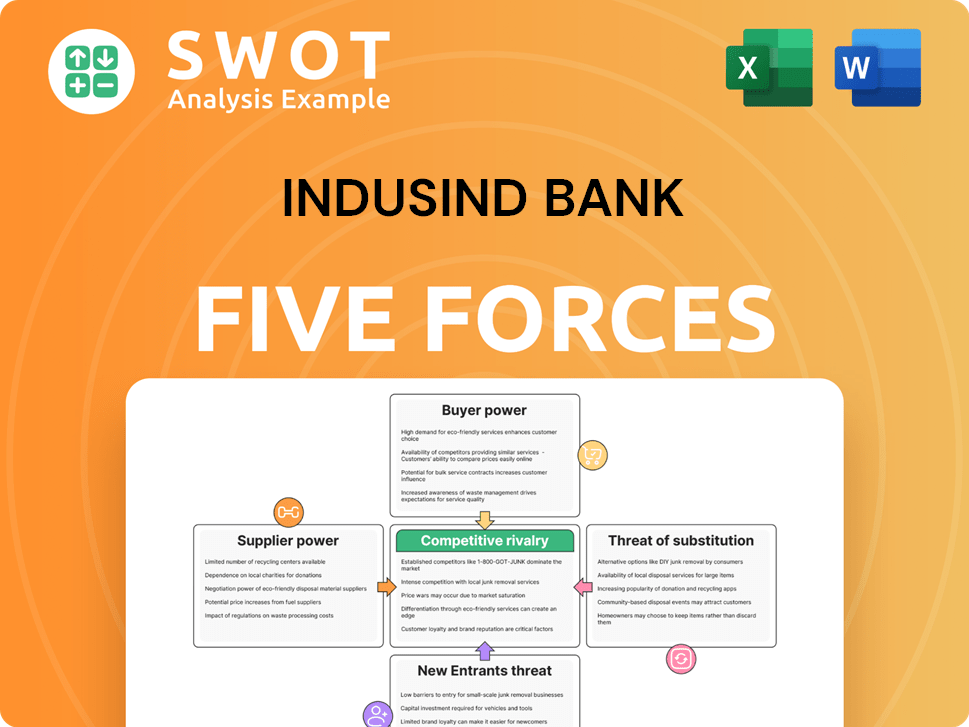
Related Blogs
- What are Mission Vision & Core Values of IndusInd Bank Company?
- What is Competitive Landscape of IndusInd Bank Company?
- What is Growth Strategy and Future Prospects of IndusInd Bank Company?
- How Does IndusInd Bank Company Work?
- What is Sales and Marketing Strategy of IndusInd Bank Company?
- What is Brief History of IndusInd Bank Company?
- What is Customer Demographics and Target Market of IndusInd Bank Company?
Disclaimer
All information, articles, and product details provided on this website are for general informational and educational purposes only. We do not claim any ownership over, nor do we intend to infringe upon, any trademarks, copyrights, logos, brand names, or other intellectual property mentioned or depicted on this site. Such intellectual property remains the property of its respective owners, and any references here are made solely for identification or informational purposes, without implying any affiliation, endorsement, or partnership.
We make no representations or warranties, express or implied, regarding the accuracy, completeness, or suitability of any content or products presented. Nothing on this website should be construed as legal, tax, investment, financial, medical, or other professional advice. In addition, no part of this site—including articles or product references—constitutes a solicitation, recommendation, endorsement, advertisement, or offer to buy or sell any securities, franchises, or other financial instruments, particularly in jurisdictions where such activity would be unlawful.
All content is of a general nature and may not address the specific circumstances of any individual or entity. It is not a substitute for professional advice or services. Any actions you take based on the information provided here are strictly at your own risk. You accept full responsibility for any decisions or outcomes arising from your use of this website and agree to release us from any liability in connection with your use of, or reliance upon, the content or products found herein.